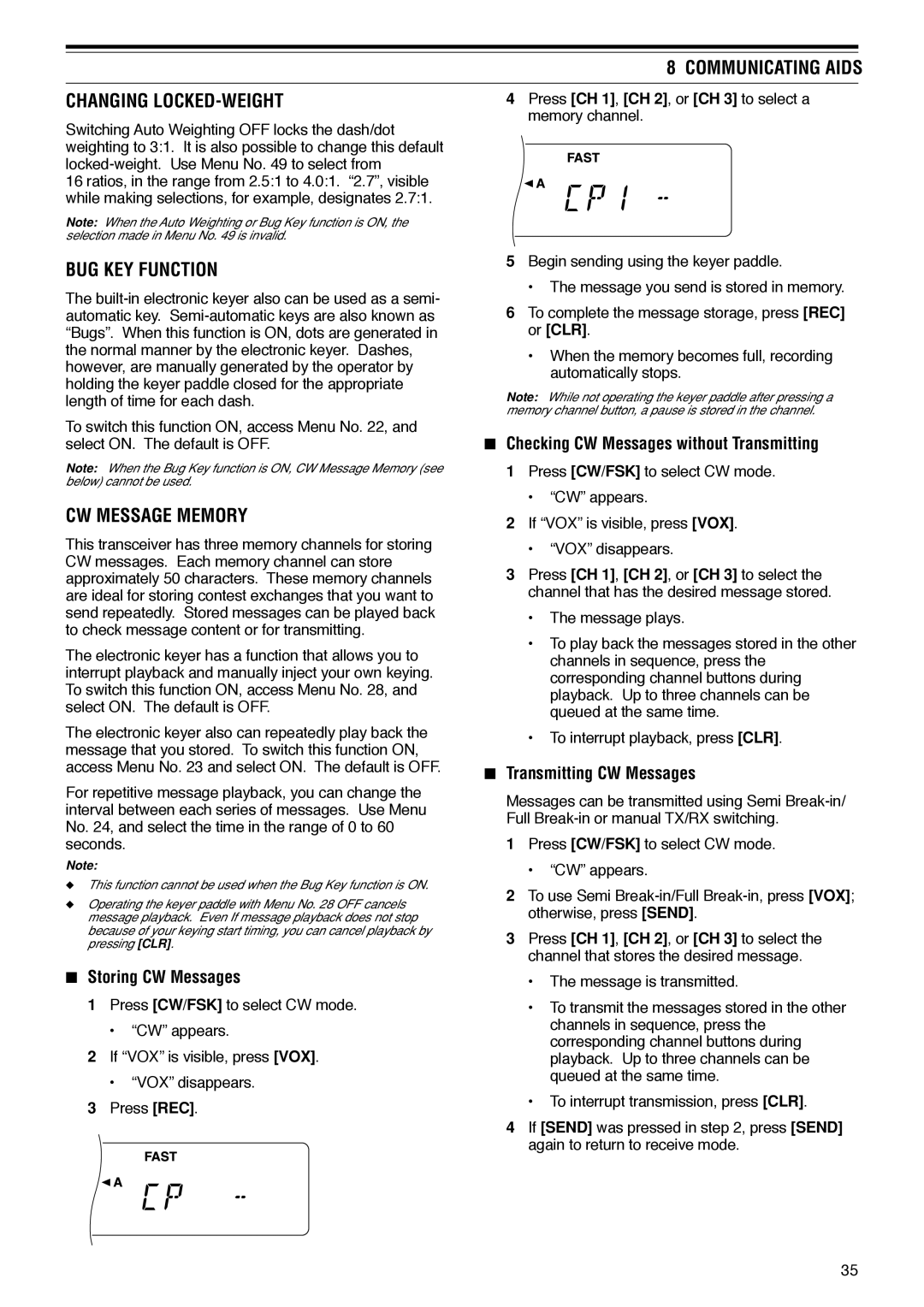
8 COMMUNICATING AIDS
CHANGING LOCKED-WEIGHT
Switching Auto Weighting OFF locks the dash/dot weighting to 3:1. It is also possible to change this default
16 ratios, in the range from 2.5:1 to 4.0:1. “2.7”, visible while making selections, for example, designates 2.7:1.
Note: When the Auto Weighting or Bug Key function is ON, the selection made in Menu No. 49 is invalid.
BUG KEY FUNCTION
The
To switch this function ON, access Menu No. 22, and select ON. The default is OFF.
Note: When the Bug Key function is ON, CW Message Memory (see below) cannot be used.
CW MESSAGE MEMORY
This transceiver has three memory channels for storing CW messages. Each memory channel can store approximately 50 characters. These memory channels are ideal for storing contest exchanges that you want to send repeatedly. Stored messages can be played back to check message content or for transmitting.
The electronic keyer has a function that allows you to interrupt playback and manually inject your own keying. To switch this function ON, access Menu No. 28, and select ON. The default is OFF.
The electronic keyer also can repeatedly play back the message that you stored. To switch this function ON, access Menu No. 23 and select ON. The default is OFF.
For repetitive message playback, you can change the interval between each series of messages. Use Menu No. 24, and select the time in the range of 0 to 60 seconds.
Note:
◆This function cannot be used when the Bug Key function is ON.
◆Operating the keyer paddle with Menu No. 28 OFF cancels message playback. Even If message playback does not stop because of your keying start timing, you can cancel playback by pressing [CLR].
■Storing CW Messages
1Press [CW/FSK] to select CW mode.
•“CW” appears.
2If “VOX” is visible, press [VOX].
•“VOX” disappears.
3Press [REC].
4Press [CH 1], [CH 2], or [CH 3] to select a memory channel.
5Begin sending using the keyer paddle.
•The message you send is stored in memory.
6To complete the message storage, press [REC] or [CLR].
•When the memory becomes full, recording automatically stops.
Note: While not operating the keyer paddle after pressing a memory channel button, a pause is stored in the channel.
■Checking CW Messages without Transmitting
1Press [CW/FSK] to select CW mode.
•“CW” appears.
2If “VOX” is visible, press [VOX].
•“VOX” disappears.
3Press [CH 1], [CH 2], or [CH 3] to select the channel that has the desired message stored.
•The message plays.
•To play back the messages stored in the other channels in sequence, press the corresponding channel buttons during playback. Up to three channels can be queued at the same time.
•To interrupt playback, press [CLR].
■Transmitting CW Messages
Messages can be transmitted using Semi
1Press [CW/FSK] to select CW mode.
•“CW” appears.
2To use Semi
3Press [CH 1], [CH 2], or [CH 3] to select the channel that stores the desired message.
•The message is transmitted.
•To transmit the messages stored in the other channels in sequence, press the corresponding channel buttons during playback. Up to three channels can be queued at the same time.
•To interrupt transmission, press [CLR].
4If [SEND] was pressed in step 2, press [SEND] again to return to receive mode.
35
